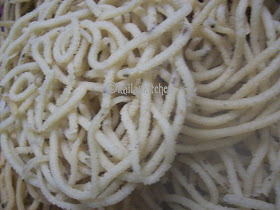
Vengaya pakoda is a very popular snack in Tamil Nadu. Its hard to find any bakery or tea stall with out selling these. These crispy pakodas is the most sought after accompaniment with a cup of hot tea/coffee. In Kerala, you will find the bajji version more popular. Pakodas are crunchy where as bajjis are crisp and soft. Though both are besan based, the batter consistency makes the difference. At my home, Amma used to make this on most of the Sundays. Post marriage, my husband's family love to have these pakodas/bajji as side for dinner. With the onset of monsoon, these will be made often in my home. This is a favorite with my hubby. There isn't any recipe for this. I usually follow eye ball measurement. without any exact measurement followed, each time it is made, it has a unique taste.
1 medium sized onion, chopped
handful of besan flour - 2 measures
handful of rice flour - 1 measure
salt to taste
a big pinch of chilli powder
few shakes of hing
chopped coriander & curry leaves (optional)
Water to prepare the batter
Oil to deep fry
Method
Mix all the ingredients well. Add water little by little to get a thick batter. The batter should not be very stiff also. Adjust the salt and chilli powder to your taste.

Heat oil in a kadai. When hot, take some batter in your hand, crumble it into small pieces, directly into the oil. Be careful as you do this over the oil. Take care that your fingers do not go near oil. The idea is to get small pieces so that it will fry crisp else it will turn soft. This is a very forgiving recipe. Little more or less of any of the ingredients will not affect the taste but the crunchiness will vary. Too much of water or besan will give soft pakoras.
Drain on absorbent papers and when cool, you can store in airtight containers.
I am sending this to RFRU:Starters hosted by Sunshinemom, an event started by Ramki.
 |






